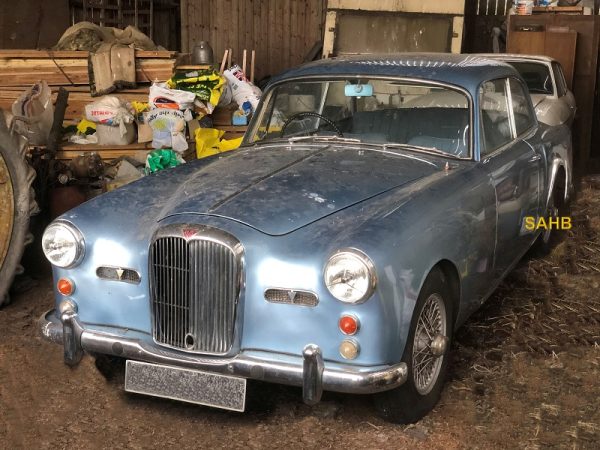
This would be a barn find if it were not for the knowledge that the owner stores his cars here. This Alvis is also in remarkably good fettle. It was seen in Yorkshire in company with two Triumphs: a TR7 and (just visible behind) a Stag.
The post-war story of Alvis is inextricably linked to a search for a reliable source of coachwork. Car production resumed in 1946 with a four-cylinder model, the TA 14, based on the pre-war 12/70. Bodies were built by Mulliners of Birmingham. Its successor the TA21 of 1950 was effectively a TA14 fitted with a new six-cylinder 3-litre engine. This highly successful powerplant would be fitted to all Alvis models until the end of car production.
The TA21 saloons were again bodied by Mulliner; the drophead coupés carried bodies by Tickford. This arrangement continued from 1953 to 1955 with the successor model, the TC21. However, in October 1954 Mulliners committed to supply only Standard Triumph, which purchased Mulliners in 1958, and Tickford was acquired by David Brown, owner of Aston Martin Lagonda, in late 1955. It thus became clear that a new coachbuilder would be needed.
The first solution was to turn to the Swiss company Carrosserie Herman Graber. They had been making one-off bodies for Alvis since the war, and bodies displayed on the 3-litre chassis at the Geneva Motor Shows in 1951 and 1952 attracted sufficient interest for Graber to set up a standing order of 30 chassis per year. Graber coupés were seen on the Alvis stand at both Paris and London Motor Shows in October 1955.
The new Graber model was the TC108/G, but production levels were miniscule. From late 1955 Willowbrook of Loughborough built 15 or 16 of these cars under licence from Graber in a period of about 2 years, and the Swiss company built only 22 in the same period. It was not until late in 1958 that full-scale production became possible, when Park Ward began to build the new bodies, with many small modifications, for the new TD21.
The car in our Snapshot is clearly the Series 1 version of the TD21: for Series 2 fog lamps were recessed into the body on either side of the radiator, inside circular air intakes. A strange feature of ‘our’ TD21 is the lack of any sign of fog lamps; on the Series 1 these were normally mounted on the front bumpers.
The TE21 of 1964 and TF21 of 1966 modernised the look of the car with vertically stacked twin headlamps. Rover took a controlling interest in Alvis in 1965 and a Rover-designed mid-engined V8 coupé prototype named the P6BS was rumoured to be the new Alvis model, but this was not to be. The 3-litre Alvis was an ageing design and only 109 of the final TF21 model were sold before production ended in 1967.







Leave a Comment